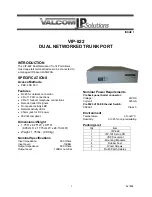
6
The Split Multi-Link Trunking (SMLT)
feature of Passport* 8000 Switches eliminates
single points of failure and allows wiring
closet switches, such as the BayStack 460,
to have multiple active connections to the
network core. The BayStack 460 Switch’s
ability to have multiple connections to a
Passport 8600 network core allows
customers to double network bandwidth
with no extra investment. The Passport
8600 provides a self-healing network
which delivers the reliability and avail-
ability required by today’s mission-critical
applications. By combining the reliability
of the Passport 8600 with the resilient
trunking features of the BayStack 460
(DMLT, MLT, etc.), Nortel Networks has
created the next generation of flexible
networking solutions
(Figure 4)
.
Common look and feel
All BayStack switches, including the
BayStack 460 Switch, have a common
“look and feel” which reduces training
costs. This allows the switches to be
managed in a similar fashion via a broad
set of management tools. These tools include Web, Command Line Interface (CLI), Java
™
-
based Device Manager (JDM), Optivity* Network Management System (NMS), Optivity
Switch Manager (OSM), and Optivity Policy Services (OPS).
End-to-end IP Telephony
The BayStack 460 Switch provides enterprises with another option for end-to-end deploy-
ment of IP Telephony. Succession* 1000, Business Communications Manager, Meridian*,
and BayStack all provide the choices that allow enterprises—from small and medium
businesses to large campus infrastructures—to deploy the solution that is right for them
and offers the flexibility to implement infrastructure changes at their own pace. Figure 5
depicts an example of a small- to mid-sized enterprise solution with the BayStack 460
Switch. Figure 6 shows an example of a large enterprise solution.
MAC addresses
BayStack 460 Switches support up to 16,000 MAC addresses per switch or stack for
deployment of large-scale enterprise networks with many attached devices and workgroups,
allowing for scalability and cost-effectiveness.
VLAN support
Up to 256 port-based VLANs can be configured per individual switch or per stack to extend
the broadcast domain and segment network traffic. The 256 VLANs can be spread among
port-based and MAC source address-based VLANs (up to a maximum of 48 MAC source
address-based VLANs). The 256 VLANs can be on a standalone switch or across a stack.
Protocol-based VLANs allow switch ports to be assigned to a broadcast domain based on the
protocol information within the packet. These VLANs can localize broadcast traffic and assure
that the specified protocol type packets are sent only to the protocol-based VLAN ports.
BayStack 460-24T-PWR Switch Stack
Passport 8600 Switch
BayStack 460-24T-PWR Switch Stack
Passport 8600 Switch
Interswitch Trunk
All ports active
Figure 4. Split Multi-Link Trunking (SMLT)


































